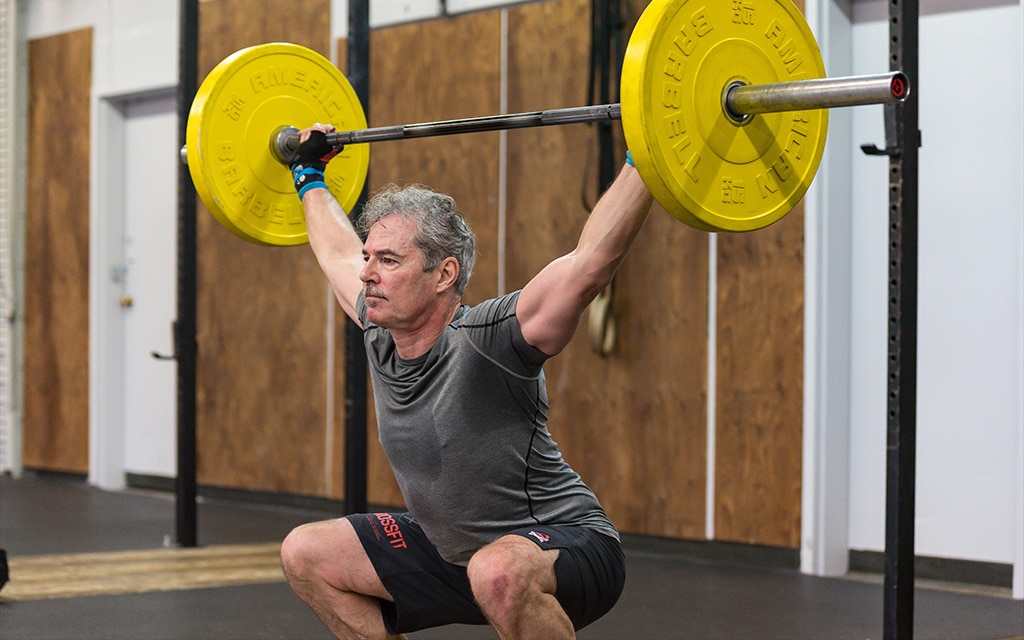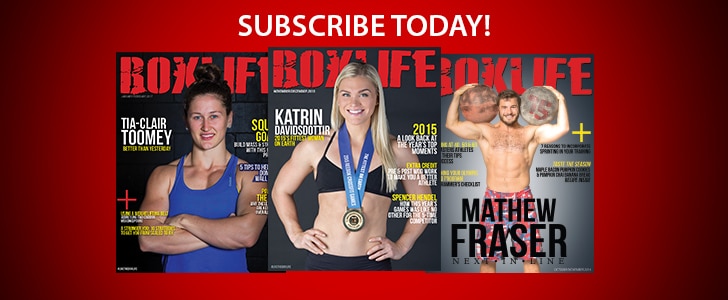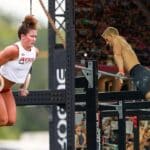Training with athletes of all ages, I’ve realized one thing—Masters athletes (typically near their 40s and older) are some of the toughest and wisest people you’ll meet. Masters athletes don’t back down from a challenge. They don’t boast about what they can do or complain about what they can’t do. They simply do what they can. They listen to their bodies. Though they do compete locally and at the Games, their goals from CrossFit are a little different than say maybe that of a 20-year-old. Having more energy to play with their kids is their goal. Losing weight is their goal. Gaining the strength to carry their groceries up a flight of stairs is their goal.
We surveyed a group of Masters athletes, male and female, ages 38-62, ranging from CrossFit newbie to CrossFit Games competitor and compiled their responses on a variety of topics.
Training
“Working and maintaining our ability to develop our fast twitch muscle fibers is key because that’s what we’re gonna lose. We will lose that capacity as we battle the factor of age.”
-Coach Chris Hinshaw (52)
CrossFit NorCal, San Jose, CA
Most of our group said they train five days a week with two days off. A few take at least one “active recovery” day, leaving one full rest day. This is not revolutionary since the CrossFit model is built around a three-on-one-off approach. Other Masters athletes supplement their WODs with additional activities, such as endurance-specific training or Olympic lifting. “I have two personal training sessions a month to work on any problem areas or to focus on specific lifts,” notes Lisa Alleman, 47, of CTOWN CrossFit in Cleveland, OH.
The key focus is not necessarily how often Masters athletes train throughout the week, but what they’re doing during their training. “I’m a one workout a day kind of girl,” says Becky Harsh (42), owner of CrossFit Beaver Menace in Castle Rock, CO and Seminar Staff for CrossFit HQ. “Over the years, I have found I’m at this party for fitness and nothing more,” she adds. Yes, if you’re trying to make it to the Games, like 2016 CrossFit Masters Games Champion Shellie Edington, volume will be a part of your training program. “I train 3 days on, 1 day rest, 2 days on, 1 day active recovery,” says the 52-year old from FitClub in Columbus, OH. “I train at least one hour [per day], and this increases as we move into the CrossFit season.” But volume is certainly not the linchpin in training. What time and experience have taught most of these athletes, including Edington, is that it’s not about the volume of work you put into your training, but the quality of the work you put in each training session.
“Unless fitness is your vocation,” says 2015 CrossFit Masters Games athlete Mike White, 62, of CrossFit Mt. Hood, in Gresham, OR. “Create the proper space for CrossFit in your life. Put in your 90 minutes at the box, and then apply yourself to the truly crucial things in life,” he adds. For majority of the athletes over 35, it’s about longevity and functionality. Or, as 37-year-old Chris Moore from CrossFit Sixth City in Cleveland, OH puts it, “I work out for two reasons: to look good naked and to eat and drink what I want, when I want and not feel guilty about it.” You can’t argue with that.
Rest
“Complete rest.”
– 2016 CrossFit Masters Champion Shellie Edington (52) on her days off
There’s a strong consensus of opinion among our Masters that rest days should in fact be just that. “I really try to preserve my rest days,” says 41-year-old Michelle Lim-Watson out of CrossFit 2A in Acton, MA. “I’ll go play with my children or go for a walk, but that’s pretty much it.” Kevin Little, 54, of CrossFit Luminary in Grand Rapids, MI is sure to listen to what his body is telling him throughout the week. “I usually take one to two rest days, but I will also take an additional rest day when I feel I need it,” says the former track athlete. The obvious conclusion most people will draw is yes, older athletes do need a bit more recovery time than our 20-something counterparts; however, there is something to be said about the pattern established and that is their familiarity with their bodies and how they’re much more dialed-in than a typical younger athlete. “People forget that when we train, we are placing a stimulus on the body. If we don’t rest, there’s no adaptation. I need that rest to create that adaptation,” says Coach Hinshaw. No matter what your age, rest is just as important as training in achieving your strength gains and avoiding injury.
Mobility & Challenges
“Stretch, keep doing mobility, and never stop.”
-Keith Smith (49)
CTOWN CrossFit, Cleveland, OH
As an athlete ages, certain movements may inevitably become more challenging due to an inherent lack of range of motion. Nevertheless, this can be easily combated with mobility training. No matter your age, it is only through diligence that we maintain mobility as we age. Out of the 10 athletes polled, four subscribe to the popular online program ROMWOD, two use therapy-balls, and one implements an online gymnastics strength program. All 10, however, regularly work a variety of mobility training into their weekly schedule—whether with barbell smashing, band work, or good old fashioned stretching. “Who doesn’t have 15-20 minutes to spare? I mean, c’mon,” prods Michelle Lim-Watson, who every evening does a ROMWOD routine with her husband. “After the kids are in bed, we do it together. It’s our time to catch up on our day, and it’s made a huge improvement.” Neglecting this important part of training leads not only to a lack of mobility, but can also lead to injury. “Over the years, I have not spent nearly the time I should have on mobility,” says Kevin Little. “I really believe that mobility should be a major focus for anyone who trains regularly.”
Without full range of motion in key areas such as the shoulders, hips, and ankles, certain movements in a WOD are extremely challenging if not impossible. Paul Schumacher, three-time Masters qualifier from CrossFit Sixth City in Cleveland, OH, knows firsthand the struggles of that reality. “I’m still striving to do hand-stand-push-ups and to get better at muscle-ups and my snatch. My shoulder mobility and overhead position needs work,” says the 52-year-old who has been doing CrossFit for over five years. In fact, several of the athletes attributed their least favorite movement to a lack of mobility or a flaw in form. “My most challenging movement is the stupid deadlift,” Chris Moore jokingly laments. “I have the worst form. It’s actually embarrassing how bad my deadlift form is.” But old dogs can certainly learn new tricks, which is the beauty of CrossFit.
That’s not to say that the most challenging moves for Masters athletes are all due to a lack of mobility. “Truth be told, it took me nine years of doing CrossFit to get a muscle up, rings and bar,” admits 42-year-old Becky Harsh. Athletes at any age level have challenges they struggle to overcome, even those who are the top performers in their age group. However, Masters athletes have a tendency to know their bodies more intimately and respect limitations more keenly. If a movement is challenging to the point that it may cause more harm than good, their egos are easily put in check as they happily scale to their needs. They don’t shy away from challenges, but they certainly don’t take unnecessary risks. “The injuries of your youth will catch up to you, so take care of yourself,” cautions Michelle Lim-Watson.
Sleep & Nutrition
“I generally pay attention to my body now. I didn’t do that for years.”
-Lisa Alleman on her health and nutrition before CrossFit
How do our Masters athletes keep their machines running? By eating clean and getting as much rest as they can. Most of our Masters said they strive for 7-8 hours of sleep a night but land somewhere closer to 6-7 on average. “I remember the exact date I became tired. It was at the age of 34, when I had my third child,” laughs Coach Hinshaw. Sleep patterns wildly differentiate depending on a range of factors. For some, traveling as a part of their career can disrupt sleeping routines. For others, having to wake up early to make the kids their breakfast and get them on the school bus certainly plays a role. Though they tend to have more “sleep deterrents” in their lives than the average-aged CrossFit athlete, our sensible Masters wholly respect the value of sleep.
To help make up for the lack of sleep time, all of our Masters athletes (with perhaps the exception of Chris Moore), fuel their bodies with healthy foods. Several of our athletes use very specific diet structures, such as Shellie Edington who found that Renaissance Periodization was the best fit for her level of training. “The RP Strength Diet Templates and corresponding education helped me tremendously in understanding how much timing affects my energy levels and body maintenance,” says the 4-time CrossFit Masters Games athlete. Michelle Lim-Watson uses a macro-based program, which has allowed her to get the right amount of energy she needs to get through her training and her busy day. Across the board, our athletes know the health and longevity benefits of eating fresh whole foods, eliminating overly processed foods, and reducing sugar. Still, our Masters also have their occasional cheat, though they are sure to never overindulge. “Every night, I need a glass of wine and something sweet, so I just make sure I fit that in ahead of time,” notes Becky Harsh, who is a staunch proponent of the Zone diet. Quite simply, Masters athletes know full well the importance of being kind to their bodies.
Mastery
“We need to be accountable for our own knowledge. I have learned that as I have gotten older, your foundation of knowledge is what keeps you motivated and confident.”
– Coach Chris Hinshaw
As Coach Hinshaw states, we are the ones who are in charge of our bodies and our health. We asked the group what advise they had for their own egos at 20-years-old. They would all encourage younger versions of themselves to rely on trustworthy, knowledgeable people to help them along the way. “Find a great coach, discuss your goals, stick to the plan, and trust in your training,” Shellie Edington recommends. “Don’t change programs every other month—stick to the plan!” she continues. “You need to speak up and you need to ask questions,” stresses Coach Hinshaw. “If your coach is asking you to do something, and you don’t understand the purpose of what your coach is asking you to do, you have to ask.” This is why it’s imperative for younger athletes and CrossFit newbies to do their research. “Find a box with a highly skilled training staff,” Mike White implores. Athletes need to take care in finding the right fit for them when it comes to a gym, a coach, and/or programming.
In addition to making healthy and prudent choices, our Masters athletes would also advise their more younger selves to challenge themselves. “Don’t be afraid of trying new things. Everyone has a choice to make and you learn from every choice. If you don’t like it, you can choose something else, and I say that in regards to CrossFit as well. Give it a try!” expresses Michelle Lim-Watson. Youth is, after all, the ideal time in a person’s life to experiment and take risks. But it is also a time that is often filled with self-doubt. On this,
Paul Schumacher would advise not only his younger self but also all younger athletes to reach beyond their perceived limitations. “We are all physically capable of more than we think, and with proper coaching and the motivation of fellow athletes, we can each exceed our physical goals or expectations. In doing so, we can reach a mental state of well being and confidence that will carry over to our jobs, relationships, and life experiences.”
If you’re a Masters athlete, keep doing what you’re doing. You’re inspiring the people around you—of all ages and abilities—even if you don’t realize it. If you’re a younger athlete, pay close attention to these athletes, there’s much to be learned from their experience.














